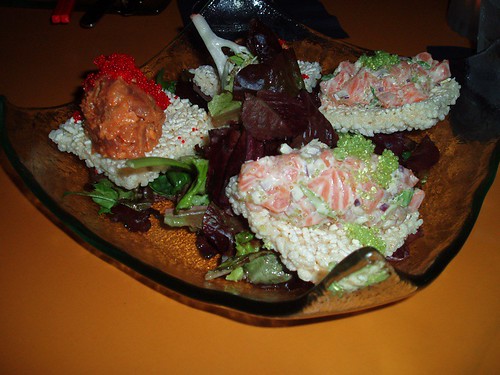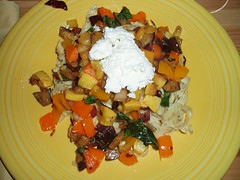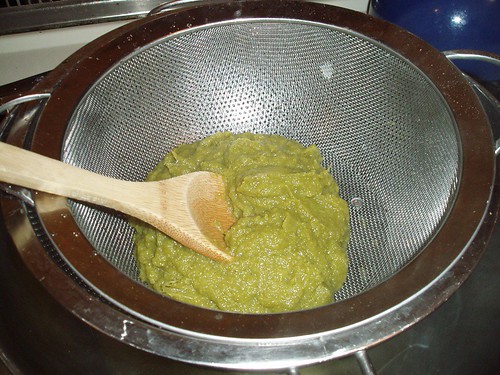So, I was out of town much of last week for my (gasp!) 5 year college reunion, and have little food news to share other than Magic Hat #9 rocks, cordials at the President's house rock too (However, would you consider Midori a legit cordial??), and Smith still makes fabulous desserts, including chocolate-whisky fondue. Also, J has absconded to South Korea with my digital camera, so I'm picture-less for the week even if I was cooking. I do have a few notes for you though:
Asparagus, Asparagus, Asparagus: Kevin at Seriously Good has rounded up a gazillion different asparagus recipes from food bloggers around the globe. Very useful reference if you love the stuff but have been running out of ideas.
Food Focused Book Review: This Sunday's NYT Book Review was all about food books--memoirs, new cookbooks, chef musings on old cookbooks, how to eat ethically. Chock full of good stuff.
Masala Meaning: It just means mix. Hence masala chai, garam masala--mixes of spices. I learned this via Jeffrey Steingarten's column in this month's Vogue--all about recent travels in India. Good reading, but you'll have to buy a copy (Uma's on the cover) because it's not online.
Tuesday, May 30, 2006
Monday, May 29, 2006
Going Local: Like a Bee to...
Note: This post is part of an ongoing report on my efforts to eat locally for the month of May. You can read about my goals, exceptions and guidelines here.

photo courtesy of the20d
When I started the Eat Local Challenge, I knew my baking habit would be problematic, so I exempted baking staples I already had around the house--flour, sugar and such--with the promise that I wouldn't buy more during May. About two weeks in, my more-meager-than-I-thought store of white sugar ran out, yet I could think of no other use for a pint of "one more day and they're gone" softening strawberries than breakfast muffins.
My go-to muffin recipe comes from the Moosewood Restaurant's New Classics cookbook. After a peek in my cupboards, I decided I would do the vegetarian collective restaurant proud by replacing the white sugar in the recipe with local honey (from Martinez Apiaries in Baldwin Park, CA-they sell at the Hollywood Farmers' Market). The muffins were denser and smaller than usual, but the flavor didn't suffer. Packed with ripe strawberries, the mild honey allowed the fruit to shine alone. This emergency substitution may become permanent!
More Moosewood than Moosewood Strawberry Muffins
6 tbsp. butter, at room temperature
1/2 c. honey
1 egg
1/2 c plus 2 tbsp milk
1/2 tsp. vanilla extract
1 pint exceedingly ripe strawberries, chopped
2 c. flour
1 tsp. baking powder
1/4 tsp. baking soda
1/4 tsp. salt
Preheat oven to 350. Prepare a 12-cup muffin tin by placing a paper liner in each cup.
In a mixing bowl, cream together the butter and honey until well-mixed. Beat in the egg, then the milk and vanilla; the mixture will look lumpy. With a rubber spatula, fold in the strawberries. Set aside.
In a large bowl, sift together the flour, baking powder, baking soda and salt. Make a well in the center of the dry ingredients, and add the wet ingredients. Fold together without overmixing. Spoon about 1/3 c. of the batter into each muffin cup.
Bake for 30-35 minutes, until golden. Remove muffins from oven and place on a rack to cool for about 15 minutes. Take out of the tins and cool a bit more before eating.
Erin's Kitchen Index: Cookies, Cakes, Breads and other treats
Tuesday, May 23, 2006
Shaved Carrot and Fennel Salad
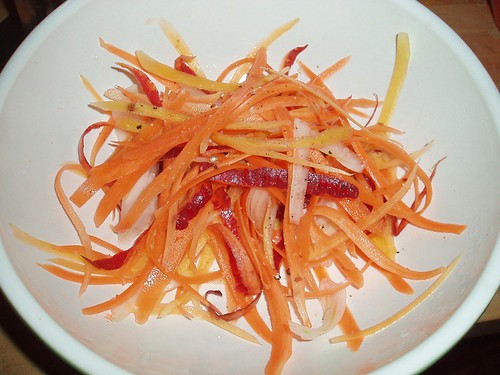
Eating locally has turned me into a carrot-lover. For the longest time, carrots meant only one thing to me: bor-ing. I'd buy them cheap from Albertson's for mirepoix, and sometimes succumb to the convenience and "health" of the faux baby carrots to pack in my lunch, but that was the extent of the Erin-carrot relationship.
All has changed. Whether inspired by Lady Tottington or sucked in by the reds, yellows and oranges at the farmers' market, carrots have become my go-to vegetable and snack this month. They've still made their way into my lunches (and my soup), but the sweet, crunchy ones fresh from the ground are an entirely different than the "babies" I'd been buying.
This shaved salad is my latest carrot adventure, thanks to "The Edge of Greatness" in the LA Times, an article exalting thin wisps of veggies. This method worked brilliantly on the carrots--the strips maintained a crispness without the hard crunch of a bigger piece. It's also a nice visual without the hard work of cutting the carrots into small sticks or some other complicated shape.
Shaved Carrot and Fennel Salad
Pick a handful of red, yellow and orange carrots (about 4-5, depending on size) and scrub 'em up good. Peel a layer off the yellow and orange to discard if you absolutely have to, but you'll want the outside peels of your red carrots in the salad, because their insides are orange. Continuing peeling the carrots in long strips into a bowl until you're left with nubbins and/or you skin your knuckles.
Next, take 1/2 a washed fennel bulb with the outside layers removed and shave off thin pieces--I think I did about 20 or so. You can and should adjust to your taste, though remember in such small pieces the fennel isn't nearly as pungently licorice. Squeeze 1/2 lemon over the whole mess, sprinkle with freshly ground pepper and largish-grained sea salt. Toss together and enjoy.
Erin's Kitchen Index: Soups, Salads, and Veggies
Sunday, May 21, 2006
Going Local, Spreading? The Farmer's Kitchen
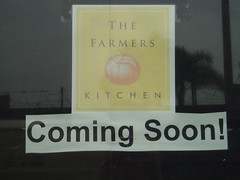
Saw this sign in the window at the space in the back corner of the Sunset + Vine complex (Morningside Court and Selma Ave), where the Sunday Hollywood Farmers' Market begins. All I can turn up is a blurb on the Sustainable Economic Enterprise's of LA's website saying:
A community space that will extend the once-a-week presence of the Farmers' Market, the Kitchen will provide a number of services and programs to the local community, with a particular focus on assistance and nutrition education for the low-income population.Anyone know any more? When it might open, what the program plan is, etc?
Saturday, May 20, 2006
Potato, Asparagus and Spicy Sausage Hash
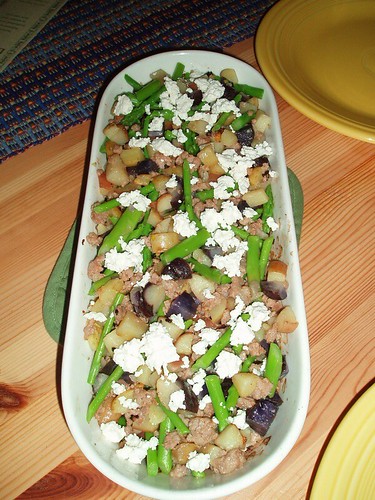
I mentioned this meal in a previous post, and Carrie asked for the recipe. I'm happy to oblige though I must confess there's not much of a recipe here. You will note a lack of measurements for ingredients--In my opinion, this type of dish can easily be altered to your tastes and what you have on hand--more asparagus, fewer potatos, no sausage. Obviously, the shallots and garlic will be in proportion to the overall size of your dish. One constant, however, is to cook each item separately and mix at the end--this way, nothing gets overdone. Also, I must apologize to the vegetarian Moosewood Restaurant--I got the hash idea from one of its cookbooks but I'm horrifying animal-lovers everywhere by adding pork.
Added note: This is also an entry for Asparagus Aspirations, hosted by Kevin at Seriously Good.
Potato, Asparagus and Spicy Sausage Hash
thin asparagus, trimmed and cut into 2-3 inch pieces
potatos, diced
shallots, finely chopped
garlic cloves, finely chopped
spicy pork sausage
ricotta salata (goat cheese or feta would be good too)
salt and pepper
olive oil (enough to coat potatos for roasting)
Preheat oven to 400.
Toss the diced potatos with shallots, garlic, olive oil, salt and pepper. Put mixture in an oven safe dish, and roast until potatos are fork tender, approx. 30-40 minutes.
While the potatos are cooking, get going on the asparagus. Set up ice bath (water with a bunch o' ice cubes in it). Boil a pot of salted water, toss asapargus in, cook for 2 minutes or so, remove pieces to ice bath (tongs work well for this). Drain, and set aside.
Once the asparagus is done, get going on the sausage. Remove sausage from casing by making a shallow vertical, and cut into pieces. Heat a saute pan over medium-high heat, and add the sausage, breaking up with a spoon as you cook it, so you end up with a crumbled pan o' meat. Once it's all uniformly brown, remove from heat and drain the grease. Cover and set aside.
When the potatos are done, add the mixture to the pan of sausage and mix gently. Add the asparagus and mix gently again. If you're gonna get fancy, put the hash in a serving dish and sprinkle cheese on top. If you're not, just sprinkle the cheese into the pan and serve yourself.
asparagus aspirations
Friday, May 19, 2006
Small Bites: Notes from About Town
Neighborhood Disappointment: New Asian-themed Tiger Lily on Vermont in Los Feliz village isn't worth your time. It's a huge, empty space and the food is overpriced. When I say empty, I mean empty--we were there on a Friday night and had about 4 other people for company in the cavernous bar. Maybe a spot for a drink.
New to me: Blair's on Rowena in Silver Lake falls into the "Why have we never eaten here?" category--it's yummy. The starters and entrees were solid upscale American fare, but the best part was dessert--vanilla bean cream-filled donuts with coffee ice cream. The still warm and bursting donuts were the Platonic donut ideal, and the best restaurant dessert I've had in ages.
Hey Cupcake: For a recent office birthday celebration, I stopped at Bluebird Bakery in Culver City for cupcakes. The carrots ones were good (more like muffins really) but the vanilla ones tasted like they were made from a box mix. The frosting was not buttercream however, more of an icing, which was refreshing.
Reconsidered: I know I called Buddha's Belly forgettable in the past, but this week I had a fantastic spinach noodle ramen there--packed with fresh veggies and a flavorful miso broth.
Tiger Lily
1739 N. Vermont Ave.
Los Angeles, CA 90027
323-661-5900
Blair's
2903 Rowena Ave
Los Angeles, CA 90039(323) 660-1882
Bluebird Bakery
Culver City, CA 90232
(310) 841-0939
Buddha's Belly
7475 Beverly Blvd
Los Angeles, CA 90036
(323) 931-8588
Tuesday, May 16, 2006
Going Local: Grill Time
Note: This post is part of an ongoing report on my efforts to eat locally for the month of May. You can read about my goals, exceptions and guidelines here.
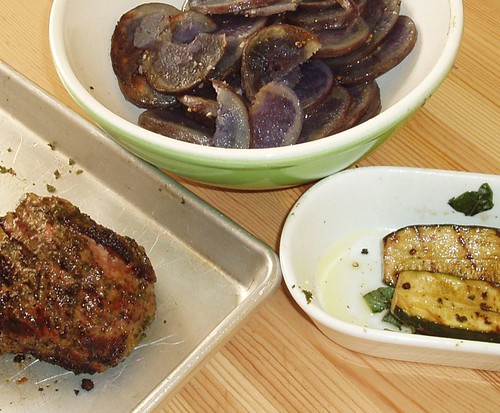
I have no dishwasher. This means more often than not, my kitchen is a disaster area. Rarely can J or I commit to the drudgery of the sink after a fabulous meal. Hence, in the summer I try to grill as much as humanly possible--all parts of the meal, if I can.
Sunday night was a perfect example: marinated and grilled pork loin, grilled zucchini strips, and for the first time, a tinfoil packet of thinly sliced potatos, tossed with salt, pepper and olive oil.
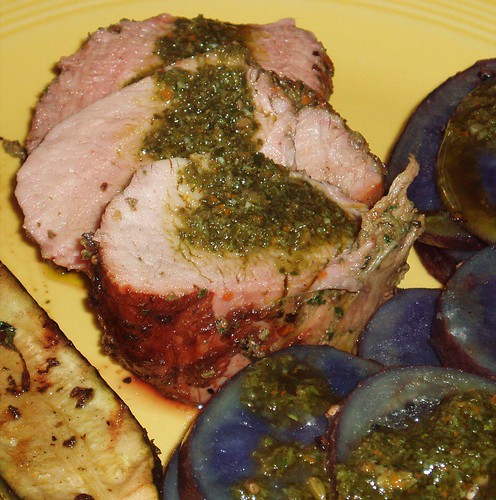
The pork loin came from Rocky Canyon, a farm committed to free-range, grass-fed cattle and pigs, in Atascadero, CA (north of Santa Barbara off the 101). The owner, Greg Nauta, runs the stand at the Hollywood Farmers' Market, and has coolers full of any cut of pork or beef you might want, plus homemade sausages and bacon. You can read a bit about the farm here in the Santa Monica Mirror, or visit the stand on Sunday mornings.
Here's the recipe for the pork loin marinade/sauce. It's slightly adapted from The Herbal Kitchen by Jerry Traunfeld. We used about 3/4 of it to marinate the pork for a couple hours before grilling, and saved the rest to use as a sauce (cooked down with the juices from the loin and a bit of vino verde). Be sure to bring your pork loin to room temperature before grilling.
Pork Loin Marinade
1 1/2-2 c. parsley sprigs
1/2 c. coarsely chopped sage leaves
Grated zest of 1 large citrus fruit (we used orange)
1/4 c. fresh citrus juice (we used a combo of lemon and orange)
2 tbsp. capers
3 cloves garlic
1 tbsp. salt
1/4 c. olive oil
Mix all ingredients except olive oil in a food processor and turn on for about 15 seconds. Scrape down the sides, then turn it on again and pour in the olive oil in a steady stream. To marinate, pour 3/4 of the sauce in a large, heavy-duty Ziploc bag. Add the pork loin, and smoosh around a bunch to get the sauce in every nook and cranny. Close the bag, making sure to get out all the air, and shake 'er up. Put in the fridge for at least 2 hours, if not overnight.

I have no dishwasher. This means more often than not, my kitchen is a disaster area. Rarely can J or I commit to the drudgery of the sink after a fabulous meal. Hence, in the summer I try to grill as much as humanly possible--all parts of the meal, if I can.
Sunday night was a perfect example: marinated and grilled pork loin, grilled zucchini strips, and for the first time, a tinfoil packet of thinly sliced potatos, tossed with salt, pepper and olive oil.

The pork loin came from Rocky Canyon, a farm committed to free-range, grass-fed cattle and pigs, in Atascadero, CA (north of Santa Barbara off the 101). The owner, Greg Nauta, runs the stand at the Hollywood Farmers' Market, and has coolers full of any cut of pork or beef you might want, plus homemade sausages and bacon. You can read a bit about the farm here in the Santa Monica Mirror, or visit the stand on Sunday mornings.
Here's the recipe for the pork loin marinade/sauce. It's slightly adapted from The Herbal Kitchen by Jerry Traunfeld. We used about 3/4 of it to marinate the pork for a couple hours before grilling, and saved the rest to use as a sauce (cooked down with the juices from the loin and a bit of vino verde). Be sure to bring your pork loin to room temperature before grilling.
Pork Loin Marinade
1 1/2-2 c. parsley sprigs
1/2 c. coarsely chopped sage leaves
Grated zest of 1 large citrus fruit (we used orange)
1/4 c. fresh citrus juice (we used a combo of lemon and orange)
2 tbsp. capers
3 cloves garlic
1 tbsp. salt
1/4 c. olive oil
Mix all ingredients except olive oil in a food processor and turn on for about 15 seconds. Scrape down the sides, then turn it on again and pour in the olive oil in a steady stream. To marinate, pour 3/4 of the sauce in a large, heavy-duty Ziploc bag. Add the pork loin, and smoosh around a bunch to get the sauce in every nook and cranny. Close the bag, making sure to get out all the air, and shake 'er up. Put in the fridge for at least 2 hours, if not overnight.
Sunday, May 14, 2006
Going Local: Dairy Dilemma
 Note: This post is part of an ongoing report on my efforts to eat locally for the month of May. You can read about my goals, exceptions and guidelines here.
Note: This post is part of an ongoing report on my efforts to eat locally for the month of May. You can read about my goals, exceptions and guidelines here. As a Wisconsin girl, I’m a fan of any and all dairy products. Of course, if I still lived in Wisconsin, getting good local dairy would be easy, while in Los Angeles, it’s proved a bit of challenge. Sure, “local” dairies like Altadena aren’t hard to find—but in a huge city like LA, local doesn’t automatically mean sustainable (Altadena’s basically a factory farm these days).
So, to answer the question left in the comments by Petra last week—where can you get local dairy products in LA? Well, an exploration of Whole Foods turned up local milk from Broguiere’s dairy, based in Montebello, CA since 1920. For yogurt, I’ve had to expand my foodshed to Northern California—I’ve been eating and baking with plain yogurt from Straus Family Creamery of Marin County—a small family dairy committed to sustainable agriculture.
The best discovery so far, though, has been Cardone’s Mozzarella. Richard Cardone makes fresh ricotta, mozzarella and boccocini right here in my neighborhood and sells it at both the Silver Lake and Atwater Village Farmers' markets every weekend. It’s fabulous stuff, especially the ricotta. In fact, we like it so much it found its way into many a dish this past week—sprinkled on our ratattoulle, mixed in our potato-asparagus hash, and stuffed inside our mint and pea ravioli. The boccocini, on the other hand, don’t mix with anything other than a plate of olive oil, salt and pepper and then head into our mouths.
I’m still looking for more local dairy options—I’m about to run out of the butter I had in the fridge before the Eat Local Challenge began. If anyone has any recommendations, please let me know in the commetns.
Friday, May 12, 2006
Going Local: The Blue Hen
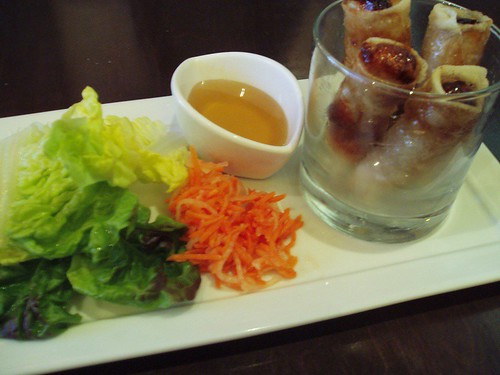 Where are the herbs? For the uninitiated (which was me until recently), you wrap your imperial rolls in a big ol' leaf of lettuce, usually incorporating carrots, cucumbers and some fresh basil, mint or cilantro.
Where are the herbs? For the uninitiated (which was me until recently), you wrap your imperial rolls in a big ol' leaf of lettuce, usually incorporating carrots, cucumbers and some fresh basil, mint or cilantro.Sometimes I think of Eagle Rock as a midwestern college town plunked down in the middle of Los Angeles. Of course there are millions of differences, but the sensibilty, particularly of the eating establishments, is the same. Small, unpretentious and reasonably priced, yet more creativity and quality than you'd expect. Anyway, it's a place we go when we're looking for quiet in this insane city.
The Blue Hen is a relatively newish addition to the eclectic mix of Eagle Rock restaurants. It's a small Vietnamese-inspired joint with a commitment to organic and local foods. Their chickens (the only meat on the menu) come from Kendor Farms, an organic, free-range place smack in the middle of the San Fernando Valley, and the produce comes from the local markets.
Despite the worthy values of the place, it could use a few tweaks. For example, considering the abundance of cheap basil and mint and cilantro at LA farmers' markets, it was strange that the Blue Hen's imperial rolls and pho came with the tiniest piles of veggies and herbs I've ever seen in a Vietnamese place. In fact, the imperial rolls came with nary an herb in sight. Also, $2.50 for a lime tonic? It was a yummy, refreshing drink--but considering it's basically lime juice and soda, a little steep.
Relatively speaking, these are minor complaints. I had a yellow curry that incorporated a nice balance of smokiness and cinammon, with a side of perfectly cooked, garlicky greens. J went for the chicken pho, and even without tons of herbs, the broth was rich and flavorful. The prices of entrees are reasonable ($7-9ish), the waitstaff friendly, and the atmosphere's pleasantly college town-esque. Plus, it's nice to see a small, low-priced place committed to local food.
The Blue Hen
1743 Colorado Blvd
Los Angeles, CA 90041
(323) 982-9900
Erin's Kitchen Restaurant Index: Los Angeles: East-ish
Tuesday, May 09, 2006
Zee Carrot Zoup
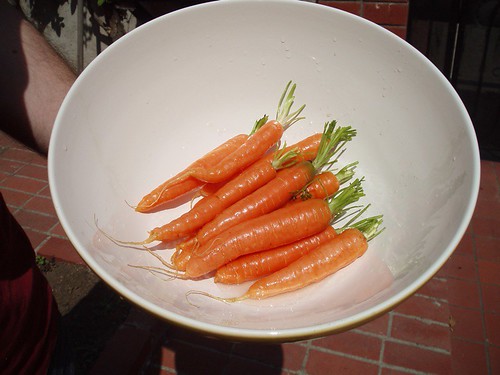
One of our first meals out in LA was at Michelangelo's, a low-key pasta/pizza joint in Silverlake, run by a family of Italian-by-way-of-Venezuela brothers. On that night over three years ago, and on many nights since, our waiter has extolled the virtues of "zee carrot zoup...eet ees very good tonight."
Despite the accolades, I've never tasted their zoup, yet when looking in my fridge last Thursday, stumped as to what to make for dinner with the last of my local produce, the waiter's voice popped into my head and some gingery, curried carrot zoup was born. Interestingly, the antioxident levels increase in carrots when you cook them, so this soup also works for Sweetnicks ARF/5-a-Day Tuesdays.
 The yogurt swirl is from Straus Family Creamery. Still stumped on truly local yogurt.
The yogurt swirl is from Straus Family Creamery. Still stumped on truly local yogurt.Zee Carrot Zoup
Start by roughly chopping a small onion, one stalk of celery, 1 1/2 lbs. carrots, and an inch square piece of fresh ginger. Toss the onion, celery and ginger in a soup pot with 1/4 c. water and a bit of butter, and cook until veggies are softened. Sprinkle with a hefty dose of curry powder, salt and pepper, then add the carrots and 4 c. of water (you could use veggie or chicken stock instead, but I was determined to stay local). Bring to a boil, then turn down to a simmer and cook 15-20 minutes until carrots are soft. Carefully and slowly whirl the soup in your blender until smooth and amazingly orange. Serve with a swirl of plain yogurt--this really helps cut the spiciness.
One sad note: I made a ton of soup and had some leftovers for lunch the next day. I found that the ginger flavor had multiplied exponentially and practically burned my throat. Not good. Maybe it needed to be cooked down a bit more?
Erin's Kitchen Index: Soups, salads and veggies
Saturday, May 06, 2006
Favorite Things Saturday: The Cook's Library
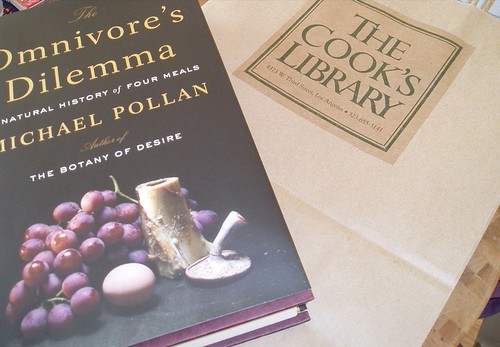
The Cook's Library, combines my two favorite things, food and books, perfect for Jill's Favorite Things Saturday. The smallish, cozy yet well-stocked shop resides at 8373 W. 3rd St in Los Angeles, between La Cienega and Fairfax, and its complimentary bookmarks read: "A bookstore dedicated to the professional as well as amateur food lover and cook." The salespeople are knowledgable and friendly, willing to order any book not currently stacked on their shelves. On Friday night, I arrived just minutes before closing and the clerk graciously welcomed me, as though I had all the time in the world. I was looking for The Omnivore's Dilemma by Michael Pollan and though I'm sure I could have found it on Amazon, it wouldn't have been as much fun.
As a side note, if you're interested in seeing Michael Pollan discuss this book--which hones in on a seemingly simple but of course endlessly complicated question: "What should we eat?"--you can join me at the downtown Los Angeles Public Library on May 10, 2006, 7 p.m. You can read more and make reservations here.
Thursday, May 04, 2006
Going Local: Vermont/Adams Farmers' Market
Note: This post is part of an ongoing report on my efforts to eat locally for the month of May. You can read about my goals, exceptions and guidelines here.
 Squash blossoms, debugged.
Squash blossoms, debugged.Wednesday is the farmers' market day in Los Angeles--well, Santa Monica to be exact. It's the day for the biggest and most diverse market in the greater LA region, the one that local chefs go to, the one highlighted each week on KCRW's Good Food. Yet, unless you're the aforementioned chef or collecting unemployment, it's daytime hours make it virtually impossible for us working stiffs to visit.
So, needing to refresh my local produce on Wednesday, I did not take an extra long lunch and head to the beach but instead left work just a tad early and stopped at the much smaller market in the St. Agnes Catholic Church parking lot just before the intersection of Vermont and Adams, a much poorer section of town than tony Santa Monica.
The Vermont/Adams market was all about green and orange. Most stands were awash in either various lettuces, collards, bok choy, cilantro, parsley and other big bunches of leafy greens or piles of oranges. There was a honey guy and an egg gal, and one prepared food stand selling icees and popcorn. Most sellers and customers were Hispanic, and my pathetic Spanish got me the location of most of the farms (predominately Riverside, east of LA, within my 100 mile radius) but not much more than that. One guy had some bunches of what I call snakegrass, he called horsetails. I asked about it and he said people make tea out of it to help with their kidneys.

I picked up squash blossoms, basil, carrots and some large, finger shaped radishes. Squash blossoms were new to me--they smell delightfully squashy and worked well in an egg scramble with fresh basil and chives. I cooked 'em up whole, but first removed the stems and stamen. Mine were also alive with teeny, tiny bugs, so be sure to wash them carefully as well.
Vermont/Adams Farmers' Market
Wednesdays, Sept-May 2 pm-5 pm, June-Aug 1 pm-6 pm
1432 W. Adams, St. Agnes Catholic Church
Just west of Vermont/Adams, on the south side of the street
Wednesday, May 03, 2006
Going Local: Risi i Bisi, a few days late
Note: This post is part of an ongoing report on my efforts to eat locally for the month of May. You can read about my goals, exceptions and guidelines here.
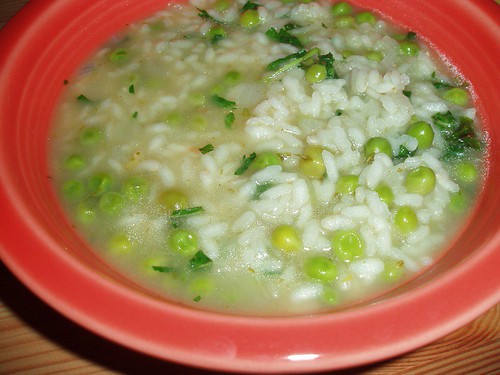
In late April, Venetians celebrate Saint Mark's Day by highlighting the first of the spring peas in a risotto-esque soup, Risi i Bisi. I know this not because I keep track of major Catholic holidays but because about this time last spring, Nigella Lawson told me so in her column in the New York Times. Since then, I've made the soup numerous times, both with fresh and frozen peas. What I'd never done, however, was use the fresh pea pods to make the stock for the soup, a recommendation from Nigella in the version of this recipe in her cookbook, Forever Summer.
This additional step meant the recipe was perfect for eating local--no worries about the provenence of canned stock, and all the veggies are in season at the farmer's market (I had the arborio rice in my cupboard already). Plus, you actually use all parts of the vegetable, and I do hate to see those beautiful pods unceremoniously dumped in the trash.
So, here's to San Marco--and a city that celebrates its saints with local food!
Risi i Bisi
slightly adapted from Nigella Lawson's Forever Summer
2 lbs shelled fresh peas, pods reserved
7 c. water
1 stalk celery
1 bay leaf
butter
1 small onion, diced (I actually subbed 1 shallot and two pearl onions)
1 c. arborio rice
handful of mint, chopped
salt and pepper
In a large stockpot, bring water, pea pods, celery and bay leaf to a boil, then turn down to a simmer. Season with salt and pepper and cook for approximately 1 hour, until pods are soft. Strain liquid into metal bowl, and run the pods thru a food mill. If you don't have a food mill, do what I did: put them in your food processor and then strain through a metal strainer into bowl of stock. Even though it's a pain, you'll want to strain so you don't end up with stringy bits in your soup.
In a large sauce pan, saute onions in butter until translucent and starting to brown. Toss in your shelled peas and stir, then add rice and stir until everything's slicked with butter. Pour all of your stock in at once, bring to a boil, then turn down and cover. Cook for 15 minutes, taste for seasoning. Mix in handful of chopped fresh mint, and serve.
Erin's Kitchen Index: Soups and salads; Easy Weeknight Meals

In late April, Venetians celebrate Saint Mark's Day by highlighting the first of the spring peas in a risotto-esque soup, Risi i Bisi. I know this not because I keep track of major Catholic holidays but because about this time last spring, Nigella Lawson told me so in her column in the New York Times. Since then, I've made the soup numerous times, both with fresh and frozen peas. What I'd never done, however, was use the fresh pea pods to make the stock for the soup, a recommendation from Nigella in the version of this recipe in her cookbook, Forever Summer.
This additional step meant the recipe was perfect for eating local--no worries about the provenence of canned stock, and all the veggies are in season at the farmer's market (I had the arborio rice in my cupboard already). Plus, you actually use all parts of the vegetable, and I do hate to see those beautiful pods unceremoniously dumped in the trash.
So, here's to San Marco--and a city that celebrates its saints with local food!
Risi i Bisi
slightly adapted from Nigella Lawson's Forever Summer
2 lbs shelled fresh peas, pods reserved
7 c. water
1 stalk celery
1 bay leaf
butter
1 small onion, diced (I actually subbed 1 shallot and two pearl onions)
1 c. arborio rice
handful of mint, chopped
salt and pepper
In a large stockpot, bring water, pea pods, celery and bay leaf to a boil, then turn down to a simmer. Season with salt and pepper and cook for approximately 1 hour, until pods are soft. Strain liquid into metal bowl, and run the pods thru a food mill. If you don't have a food mill, do what I did: put them in your food processor and then strain through a metal strainer into bowl of stock. Even though it's a pain, you'll want to strain so you don't end up with stringy bits in your soup.
In a large sauce pan, saute onions in butter until translucent and starting to brown. Toss in your shelled peas and stir, then add rice and stir until everything's slicked with butter. Pour all of your stock in at once, bring to a boil, then turn down and cover. Cook for 15 minutes, taste for seasoning. Mix in handful of chopped fresh mint, and serve.
Erin's Kitchen Index: Soups and salads; Easy Weeknight Meals
Monday, May 01, 2006
Going Local, Day 1: Well Prepped
Note: This post is part of an ongoing report on my efforts to eat locally for the month of May. You can read about my goals, exceptions and guidelines here.
When I was a kid, my parents always made me get everything ready for school the night before--pack my lunch, organize my backpack, lay out my clothes. I still (mostly) adhere to this method, and have decided to use it as my guiding principle for eating locally as well--getting ready on the weekends for a week of meals. One of my biggest concerns joining the Eat Local Challenge was time--I work relatively long and sometimes unpredictable hours, and I didn't want to fall off the wagon some night at 10 p.m., scarfing tacos from the stand down the street.
So--be prepared. First, I needed the local ingredients of course, so a trip to the Hollywood Farmers' Market was in order. I discovered a new-to-me stand, Mitchell Herbs and Specialty Produce, out of Redlands, CA, about 70 miles east of Los Angeles. Doug Powell farms 2 1/2 acres originally purchased by his in-laws and specializes in onions, garlic, lettuce, carrots, beets, fava beans and blackberries. He sells only at farmers' markets and to Farm Artisan Restaurant in Redlands. (You can read more about his farm here, though registration is required.) I picked up shallots, pearl onions, spring onions and yellow onions at his stand.
After the shopping ended, I spent the rest of the weekend baking bread, kneading pasta dough and sauteeing tomatos and onions. Some of each ended up in the freezer, some in the fridge, and tonight, some in my belly. J and I ate a late dinner of marjoram-flecked tagliatelle tossed with a simple tomato sauce. All we had to do when we came home was roll out the pasta dough, a fun and easy task, cook the noodles, and warm the sauce.
My basic tomato sauce recipe is easy to make in bulk, can be dressed up in myriad ways, works well with pasta, and makes a great pizza sauce if you run it through your food processor. Usually at the farmers' market you can find bins of cheapo tomatos marked "good for sauces and salsa" which means they're a bit soft and kinda ugly, but taste just fine.
Basic Tomato Sauce
fresh tomatos, seeded and chopped
1 yellow onion for every 2 lbs. tomatos, finely diced
3 cloves garlic for every 2 lbs. tomatos, finely diced or pressed
bouquet garni of fresh marjoram, basil and thyme
olive oil
salt and pepper
Saute your onions in some olive oil over medium heat, until they are uniformly soft and starting to brown. Add garlic, let sizzle a minute or two. Then add your tomatos and your bouquet garni. Season with salt and pepper. Bring to a boil, then turn down to a simmer. Depending on how thick you like your sauce, how finely you chopped your tomatos, and/or how big a batch you're making, simmer over low heat for at least 1/2 hour and up to 2 hours.
Erin's Kitchen Index: Pasta, Rice and Eggs
When I was a kid, my parents always made me get everything ready for school the night before--pack my lunch, organize my backpack, lay out my clothes. I still (mostly) adhere to this method, and have decided to use it as my guiding principle for eating locally as well--getting ready on the weekends for a week of meals. One of my biggest concerns joining the Eat Local Challenge was time--I work relatively long and sometimes unpredictable hours, and I didn't want to fall off the wagon some night at 10 p.m., scarfing tacos from the stand down the street.
So--be prepared. First, I needed the local ingredients of course, so a trip to the Hollywood Farmers' Market was in order. I discovered a new-to-me stand, Mitchell Herbs and Specialty Produce, out of Redlands, CA, about 70 miles east of Los Angeles. Doug Powell farms 2 1/2 acres originally purchased by his in-laws and specializes in onions, garlic, lettuce, carrots, beets, fava beans and blackberries. He sells only at farmers' markets and to Farm Artisan Restaurant in Redlands. (You can read more about his farm here, though registration is required.) I picked up shallots, pearl onions, spring onions and yellow onions at his stand.
After the shopping ended, I spent the rest of the weekend baking bread, kneading pasta dough and sauteeing tomatos and onions. Some of each ended up in the freezer, some in the fridge, and tonight, some in my belly. J and I ate a late dinner of marjoram-flecked tagliatelle tossed with a simple tomato sauce. All we had to do when we came home was roll out the pasta dough, a fun and easy task, cook the noodles, and warm the sauce.
My basic tomato sauce recipe is easy to make in bulk, can be dressed up in myriad ways, works well with pasta, and makes a great pizza sauce if you run it through your food processor. Usually at the farmers' market you can find bins of cheapo tomatos marked "good for sauces and salsa" which means they're a bit soft and kinda ugly, but taste just fine.
Basic Tomato Sauce
fresh tomatos, seeded and chopped
1 yellow onion for every 2 lbs. tomatos, finely diced
3 cloves garlic for every 2 lbs. tomatos, finely diced or pressed
bouquet garni of fresh marjoram, basil and thyme
olive oil
salt and pepper
Saute your onions in some olive oil over medium heat, until they are uniformly soft and starting to brown. Add garlic, let sizzle a minute or two. Then add your tomatos and your bouquet garni. Season with salt and pepper. Bring to a boil, then turn down to a simmer. Depending on how thick you like your sauce, how finely you chopped your tomatos, and/or how big a batch you're making, simmer over low heat for at least 1/2 hour and up to 2 hours.
Erin's Kitchen Index: Pasta, Rice and Eggs
Subscribe to:
Comments (Atom)

